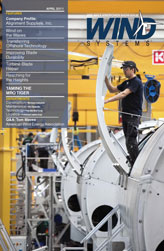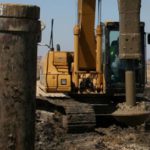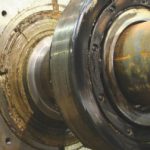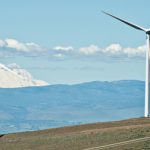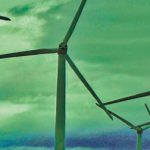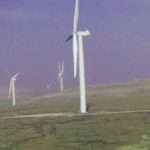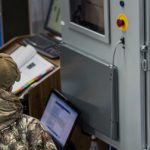President Obama’s State of the Union address in January was touted as this generation’s “Sputnik moment.” When it comes to clean energy, his commitment was bold: 80 percent of America’s electricity will come from clean energy sources by 2035. His statement, combined with the completion of the federal permitting process for Cape Wind—set to be the U.S.’s first offshore wind farm—indicates an acceleration in the development of a industry which, up until recently, has been painfully slow.
On February 7, the U.S. Department of Energy released a long awaited plan “A National Offshore Wind Strategy: Creating an Offshore Wind Energy Industry in the United States.” In it the department recognizes some of the challenges facing the industry, “The major challenges facing deployment of offshore wind power in U.S. waters include the high costs of offshore wind facilities; the technical challenges and lack of current infrastructure to support the fabrication, installation, interconnection, operations and maintenance of these systems; and the permitting challenges related to the lack of site data and lack of experience with new or developing permitting processes for projects in federal and state waters.” [1]
This is an excellent sign of progress. In North America private industry and politicians alike are now grappling with the practicalities of building a varied clean energy portfolio and encouraging the development of new renewable energy industries such as offshore wind. To do this officials and interested parties here would do well to look to the European experience to build a viable industry, create jobs, and most importantly, tap sustainable energy sources.
Tremendous Potential
The U.S. coastline holds great potential for developments in offshore wind. Last fall the U.S. Department of Energy’s National Renewable Energy Laboratory (NREL) estimated that 4,150 gigawatts (GW) of potential offshore wind turbine nameplate capacity (maximum turbine capacity) are available off U.S. coastlines, which, according to the U.S. Energy Information Administration, far exceeds the 1,010 GW, which was the nation’s total electricity-generating capacity in 2008. [2]
Projects in Massachusetts, Rhode Island, New York, New Jersey, Delaware, and Ohio are all moving through the permitting process. In Maine, a center of excellence for floating turbines is well on its way to being established. In Canada, the province of Ontario has a feed-in-tariff in place that has resulted in a number of viable projects in the Great Lakes that are also moving forward. With Google recently announcing plans to participate in the development of an undersea power cable network along the mid-Atlantic coast that will cover 350 miles from New Jersey to Virginia and deliver the capacity to connect 6,000 MW of offshore wind turbines, it would seem that the U.S. renewables market is showing some signs of genuine progress. The U.S. Department of Energy seems confident that an offshore wind renewables market will develop, estimating that 54 GW of offshore wind could be included in the 300 GW required to meet 20 percent of U.S. electricity needs by 2030.
From policy and permitting to financing, supply chain, and public acceptance, in the U.S. each state is moving forward, learning as they go. U.S. government agencies at the federal and state levels, Canadian provincial governments, utilities, project developers, consultants, turbine manufacturers, cable manufacturers, vessel operators, ports authorities, and potential investors are all at the early stages of grappling with the issue of setting up a viable industry in North America—challenges that the European market has a decade’s worth of experience in solving. Figure 1
Global Marine Systems Ltd. is an experienced player in the European offshore wind energy market, having been involved in many of the projects now operating in the North Sea and now having invested in the creation of a new American-owned company, Global Marine Energy Inc. At Global Marine Energy we believe there is a significant opportunity to learn from both the successes and mistakes made across the Atlantic in order to build a viable U.S. offshore wind industry. Specifically, three areas stand out: policy, expertise, and equipment.
Policy: The Need for a Regional Approach
Over the past 10-15 years governments in the U.K., Denmark, Germany, the Netherlands, and others have collectively put together some of the most advanced government policy to encourage and ultimately require the migration away from fossil fuel-dependent energy production. In each country the motivation for doing this may differ, and the resulting policy methods may reflect the political climate and habits common to that specific country, but the result is the beginnings of the creation of a common market. The concept that developers, suppliers, and installers can consider a regional market that surrounds the North Sea is integral to the current and future success of offshore wind.
The policy models are an important asset that Europe has and North America does not, with the exception of Ontario, Canada. The “know how” to politically accomplish this feat is a real asset created by Europeans that could and should be exported across the Atlantic. It certainly wouldn’t be the first time European legal structures and tax policies played an important role in how North America went about its business.
Consider cable installation, which is an important component to all offshore transmission. It costs something in the region of $160 million to build an installation vessel. When constructing an argument for investment in such assets, being able to point to a regional North Sea market—rather than the market of one country or another—decreases risk and encourages investment. Common policy as an expression of government commitment is the foundation of this. Figure 2
Now consider the North American Eastern Seaboard, or the Great Lakes. These are also regions with multiple governing bodies. In the case of the Great Lakes there are seven states on the U.S. side, and one province on the Canadian side. On the Atlantic there are up to 15 interested states and three Canadian provinces. In each case these entities have authority over their territorial waters, which is up to three miles out in the U.S. The complexity, not to mention the politics, is mind boggling, but it is easy to see—no regional policy means a fragmented market and no industry. It also means that regions continually rely on imported energy sources. Take a state like Maine, where public and private entities are estimated to have spent and exported over $6.5 billion on energy out of the state. Offshore wind energy may give many U.S. states that are currently net importers of energy the opportunity to be more self-sufficient and keep jobs and money in state. If the U.S. looks to the European regional model of a common market, the seeds of a new industry are sown.
Expertise: The Need for Local Talent
With somewhere between 3-4GW currently in the water and another 20-30 GW already permitted and anticipated by 2020, Europe has a significant amount of unique experience which the rest of the world wants. Such experience is made, however, not born.
Take a city like Bremerhaven, a coastal city in Germany. Following a tough period of high unemployment in the early 2000s, Bremerhaven’s political and economic stakeholders looked the existing expertise and infrastructure in the region and recognized an opportunity to capitalize on the burgeoning offshore wind farm industry. The city council made a proactive, concerted push to build the city into a hub for the offshore wind industry, attracting manufacturers, engineers, and installation and maintenance companies into the area. An industry network organization was established, and the city council went about persuading burgeoning European offshore wind farm suppliers to set up manufacturing and shipping hubs in the port. The city is also home to two major research and development facilities, encouraging future generations of offshore wind farm experts. As a result, since 2003 the city has generated upwards of 700 new jobs in the offshore energy industry. By making itself attractive to investors and companies with an interest in offshore wind, the city has continually attracted further growth. Figure 3
It should be more than just food for thought that some of our older working seaports that dot the Atlantic coast and have struggled for decades to find a new industrial foundation could play a similar role in the market development in North America. But only with proactive policy will it have the opportunity to mirror the experience of Bremerhaven.
Equipment: The Need for Local Industry
Similar to expertise, the equipment used to install offshore wind farms is unique. The necessary vessels, barges, cables, turbines, and substations are largely custom-built for this market. The engineering knowledge and manufacturing experience to produce this equipment is, at the current time, European. Yes, American law such as the Jones Act prevents European vessels from working on American projects, which means that the European naval engineering needed to build such vessels will be in demand here. Also, equipment such as purpose-built ROVs, ploughs, and trenching equipment all need to be either built or modified to fit the specific needs of this market. In the case of marine power cable it is a well-known fact that there is little if any North American manufacturing capacity for this product. Where will it come from? Well, the majority of the world’s marine power cable manufacturers are, today, European and Asian.
Along the same lines the need for skilled labor to design, build, and operate this equipment and the resulting project infrastructure is clear. Although offshore wind is by no means the answer to all of our employment issues, the expertise and employment necessary to correctly build out offshore power generation and transmission is a real opportunity. There is no reason why qualified Americans and Canadians respectively can’t be trained using the experience, processes, and methods developed in Europe over the past decade to build out what will be an important, industrial-scale, carbon-neutral, ongoing contribution to the supply of our energy.
Conclusion
There is a real opportunity today for anyone involved in offshore transmission and offshore wind development to look to the North Sea’s experience and apply its real, practical lessons to the developing North American markets. These lessons—as illustrated through policy, experience, and equipment—have been learned the hard way through trial and error. Applying them will allow for future projects wherever they may be to be built on time and on budget, with decreased risk and satisfied investors.
To date the North Sea has been the epicenter of offshore wind farm installations, and by understanding European best practices for tax policy, project finance, design, engineering, materials, and ultimately operations maintenance models, the North American market might avoid many pitfalls. Just as significantly it might accelerate its growth to a market large enough to cost-effectively provide a significant amount of carbon-neutral energy for its customers. That would truly mark this as the industry’s “Sputnik Moment.”
References:
1) A National Offshore Wind Strategy: Creating an Offshore Wind Energy Industry in the United States, www1.eere.energy.gov/windandhydro/pdfs/national_offshore_wind_strategy.pdf
2) National Renewable Energy Laboratory (NREL), “Assessment of Offshore Wind Energy Resources for the United States,” September 2010, www.nrel.gov/news/press/2010/885.html



















